

The U.S. has reported more than 80.2 million confirmed COVID-19 cases as of April 26. There have been more than 983,000 reported deaths from COVID-19-related causes — the highest death toll of any country.
The extent of the spread of the novel coronavirus continues to vary considerably from state to state, and from city to city. Even as the number of daily new cases is flattening or even declining in some parts of the country, it is surging at a growing rate in others.
Nationwide, the number of new cases is growing at a steady rate. There were an average of 12.6 daily new coronavirus cases per 100,000 Americans in the week ending April 26, essentially unchanged from the week prior, when there were an average of 10.0 daily new coronavirus cases per 100,000 people.
Metropolitan areas with a high degree of mobility and a large population may be particularly vulnerable to outbreaks. While science and medical professionals are still studying how exactly the virus spreads, experts agree that outbreaks are more likely to occur in group settings where large numbers of people routinely have close contact with one another. Cities with high concentrations of dense spaces such as colleges, correctional facilities, and nursing homes are particularly at risk.
The city with the highest seven-day average of new daily COVID-19 cases per capita is in Texas. In the Wichita Falls, TX, metro area, there were an average of 65.0 daily new coronavirus cases per 100,000 residents in the week ending April 26, the most of any U.S. metro area. Other cities where COVID-19 is growing the fastest include St. Joseph, MO-KS; Utica-Rome, NY; and Champaign-Urbana, IL.
To determine the metropolitan area in each state where COVID-19 is growing the fastest, 24/7 Wall St. compiled and reviewed data from state and local health departments. We ranked metropolitan areas according to the average number of new daily COVID-19 cases per 100,000 residents in the seven days ending April 26. Data was aggregated from the county level to the metropolitan area level using boundary definitions from the U.S. Census Bureau. Population data used to adjust case and death totals came from the U.S. Census Bureau’s 2019 American Community Survey and are five-year estimates. Unemployment data is from the Bureau of Labor Statistics and is seasonally adjusted.

Alabama: Huntsville
Avg. new daily cases in Huntsville in week ending April 26: 9.4 per 100,000
Avg. new daily cases in Huntsville in week ending April 19: 5.8 per 100,000
COVID-19 cases in Huntsville as of April 26: 114,501 (25,054.8 per 100,000)
Peak pandemic unemployment in Huntsville: 11.4% (April 2020)
Huntsville population: 457,003 (335.7 people per sq. mi.)

Alaska: Anchorage
Avg. new daily cases in Anchorage in week ending April 26: 24.2 per 100,000
Avg. new daily cases in Anchorage in week ending April 19: 22.0 per 100,000
COVID-19 cases in Anchorage as of April 26: 138,965 (34,837.1 per 100,000)
Peak pandemic unemployment in Anchorage: 14.8% (April 2020)
Anchorage population: 398,900 (15.2 people per sq. mi.)
These are all the counties in Alaska where COVID-19 is slowing (and where it’s still getting worse).

Arizona: Phoenix-Mesa-Chandler
Avg. new daily cases in Phoenix in week ending April 26: 5.4 per 100,000
Avg. new daily cases in Phoenix in week ending April 19: 8.4 per 100,000
COVID-19 cases in Phoenix as of April 26: 1,407,820 (29,566.1 per 100,000)
Peak pandemic unemployment in Phoenix: 12.8% (April 2020)
Phoenix population: 4,761,603 (326.9 people per sq. mi.)

Arkansas: Little Rock-North Little Rock-Conway
Avg. new daily cases in Little Rock in week ending April 26: 3.8 per 100,000
Avg. new daily cases in Little Rock in week ending April 19: 3.7 per 100,000
COVID-19 cases in Little Rock as of April 26: 196,165 (26,616.1 per 100,000)
Peak pandemic unemployment in Little Rock: 11.2% (April 2020)
Little Rock population: 737,015 (180.4 people per sq. mi.)

California: Visalia
Avg. new daily cases in Visalia in week ending April 26: 22.9 per 100,000
Avg. new daily cases in Visalia in week ending April 19: 16.8 per 100,000
COVID-19 cases in Visalia as of April 26: 135,110 (29,251.0 per 100,000)
Peak pandemic unemployment in Visalia: 19.5% (May 2020)
Visalia population: 461,898 (95.7 people per sq. mi.)

Colorado: Boulder
Avg. new daily cases in Boulder in week ending April 26: 33.7 per 100,000
Avg. new daily cases in Boulder in week ending April 19: 24.9 per 100,000
COVID-19 cases in Boulder as of April 26: 64,636 (20,041.5 per 100,000)
Peak pandemic unemployment in Boulder: 9.8% (April 2020)
Boulder population: 322,510 (444.1 people per sq. mi.)

Connecticut: Bridgeport-Stamford-Norwalk
Avg. new daily cases in Bridgeport in week ending April 26: 27.3 per 100,000
Avg. new daily cases in Bridgeport in week ending April 19: 25.2 per 100,000
COVID-19 cases in Bridgeport as of April 26: 207,102 (21,940.5 per 100,000)
Peak pandemic unemployment in Bridgeport: 10.6% (July 2020)
Bridgeport population: 943,926 (1,510.5 people per sq. mi.)

Delaware: Dover
Avg. new daily cases in Dover in week ending April 26: 20.3 per 100,000
Avg. new daily cases in Dover in week ending April 19: 3.3 per 100,000
COVID-19 cases in Dover as of April 26: 50,702 (28,694.0 per 100,000)
Peak pandemic unemployment in Dover: 17.3% (May 2020)
Dover population: 176,699 (301.4 people per sq. mi.)

Florida: Miami-Fort Lauderdale-Pompano Beach
Avg. new daily cases in Miami in week ending April 26: 20.4 per 100,000
Avg. new daily cases in Miami in week ending April 19: 14.5 per 100,000
COVID-19 cases in Miami as of April 26: 2,182,939 (35,840.8 per 100,000)
Peak pandemic unemployment in Miami: 13.8% (April 2020)
Miami population: 6,090,660 (1,199.6 people per sq. mi.)

Georgia: Savannah
Avg. new daily cases in Savannah in week ending April 26: 5.8 per 100,000
Avg. new daily cases in Savannah in week ending April 19: 5.9 per 100,000
COVID-19 cases in Savannah as of April 26: 85,929 (22,259.3 per 100,000)
Peak pandemic unemployment in Savannah: 15.7% (April 2020)
Savannah population: 386,036 (288.1 people per sq. mi.)

Hawaii: Kahului-Wailuku-Lahaina
Avg. new daily cases in Kahului in week ending April 26: 16.8 per 100,000
Avg. new daily cases in Kahului in week ending April 19: 11.6 per 100,000
COVID-19 cases in Kahului as of April 26: 30,407 (18,319.8 per 100,000)
Peak pandemic unemployment in Kahului: 34.8% (April 2020)
Kahului population: 165,979 (142.9 people per sq. mi.)
These are all the counties in Hawaii where COVID-19 is slowing (and where it’s still getting worse).

Idaho: Boise City
Avg. new daily cases in Boise City in week ending April 26: 4.8 per 100,000
Avg. new daily cases in Boise City in week ending April 19: 3.9 per 100,000
COVID-19 cases in Boise City as of April 26: 202,658 (28,513.5 per 100,000)
Peak pandemic unemployment in Boise City: 12.6% (April 2020)
Boise City population: 710,743 (60.4 people per sq. mi.)
These are all the counties in Idaho where COVID-19 is slowing (and where it’s still getting worse).
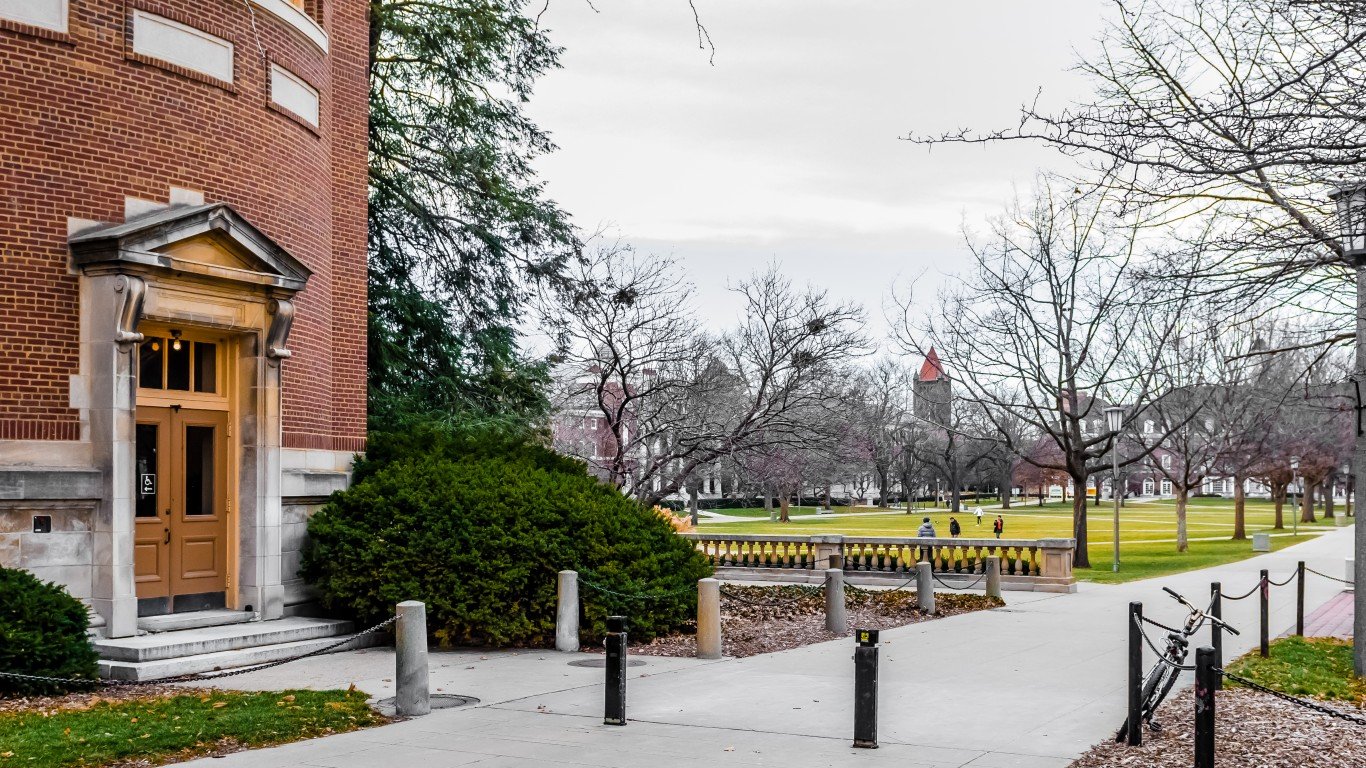
Illinois: Champaign-Urbana
Avg. new daily cases in Champaign in week ending April 26: 57.4 per 100,000
Avg. new daily cases in Champaign in week ending April 19: 50.3 per 100,000
COVID-19 cases in Champaign as of April 26: 69,061 (30,514.4 per 100,000)
Peak pandemic unemployment in Champaign: 12.2% (April 2020)
Champaign population: 226,323 (157.7 people per sq. mi.)

Indiana: Lafayette-West Lafayette
Avg. new daily cases in Lafayette in week ending April 26: 13.4 per 100,000
Avg. new daily cases in Lafayette in week ending April 19: 6.8 per 100,000
COVID-19 cases in Lafayette as of April 26: 59,229 (25,916.1 per 100,000)
Peak pandemic unemployment in Lafayette: 13.8% (April 2020)
Lafayette population: 228,541 (139.1 people per sq. mi.)
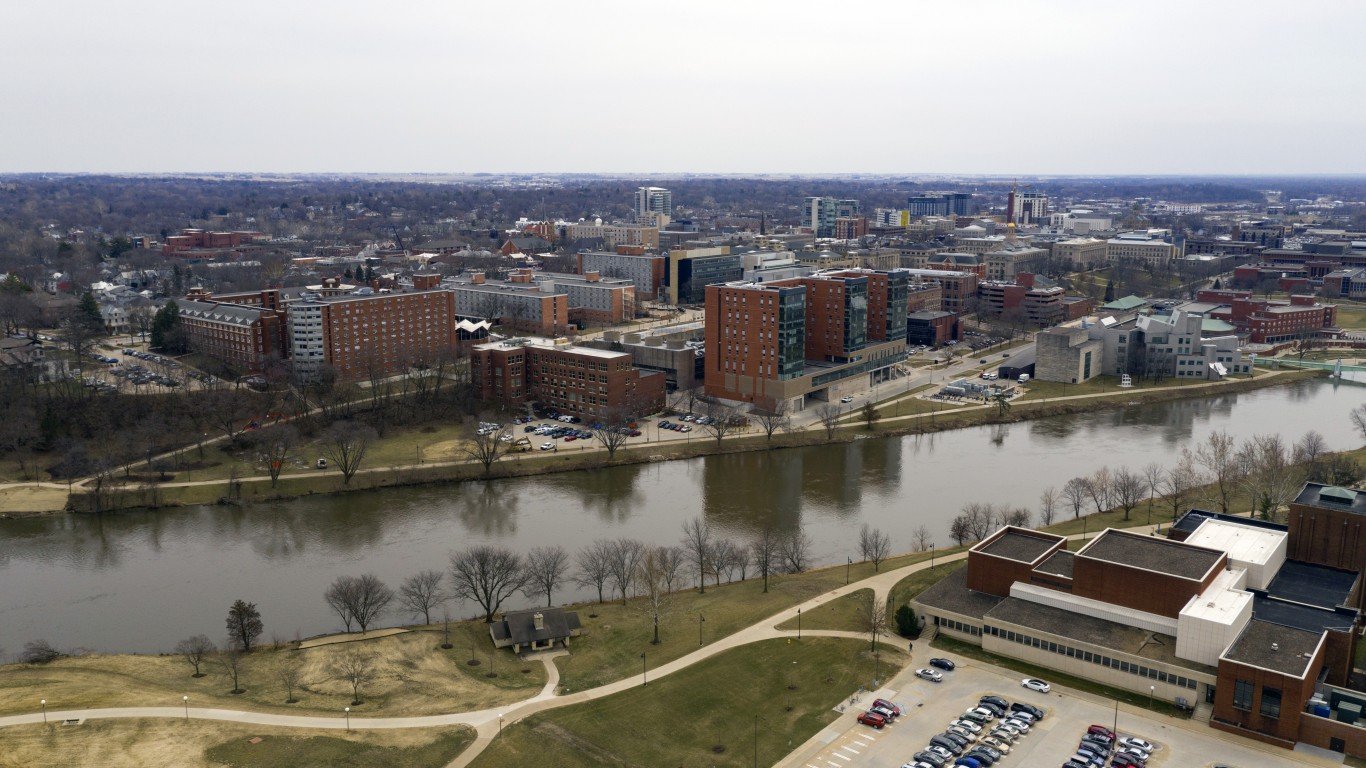
Iowa: Iowa City
Avg. new daily cases in Iowa City in week ending April 26: 14.8 per 100,000
Avg. new daily cases in Iowa City in week ending April 19: 12.6 per 100,000
COVID-19 cases in Iowa City as of April 26: 40,017 (23,446.0 per 100,000)
Peak pandemic unemployment in Iowa City: 10.1% (April 2020)
Iowa City population: 170,677 (144.3 people per sq. mi.)
These are all the counties in Iowa where COVID-19 is slowing (and where it’s still getting worse).
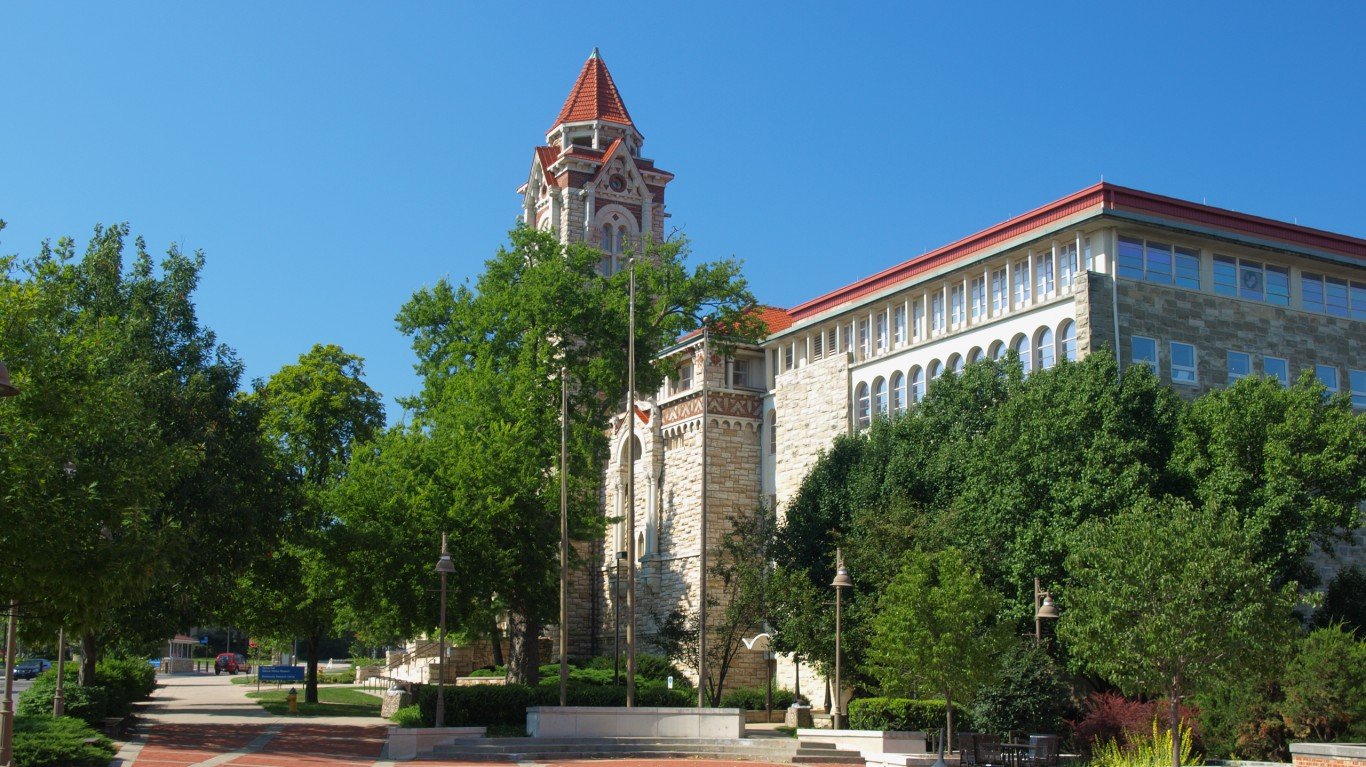
Kansas: Lawrence
Avg. new daily cases in Lawrence in week ending April 26: 35.5 per 100,000
Avg. new daily cases in Lawrence in week ending April 19: – per 100,000
COVID-19 cases in Lawrence as of April 26: 26,281 (21,848.0 per 100,000)
Peak pandemic unemployment in Lawrence: 12.1% (April 2020)
Lawrence population: 120,290 (263.9 people per sq. mi.)
These are all the counties in Kansas where COVID-19 is slowing (and where it’s still getting worse).

Kentucky: Lexington-Fayette
Avg. new daily cases in Lexington in week ending April 26: 15.6 per 100,000
Avg. new daily cases in Lexington in week ending April 19: 18.0 per 100,000
COVID-19 cases in Lexington as of April 26: 151,005 (29,571.3 per 100,000)
Peak pandemic unemployment in Lexington: 15.8% (April 2020)
Lexington population: 510,647 (347.7 people per sq. mi.)

Louisiana: New Orleans-Metairie
Avg. new daily cases in New Orleans in week ending April 26: 7.7 per 100,000
Avg. new daily cases in New Orleans in week ending April 19: 4.2 per 100,000
COVID-19 cases in New Orleans as of April 26: 307,211 (24,232.3 per 100,000)
Peak pandemic unemployment in New Orleans: 20.0% (April 2020)
New Orleans population: 1,267,777 (396.0 people per sq. mi.)

Maine: Bangor
Avg. new daily cases in Bangor in week ending April 26: 24.6 per 100,000
Avg. new daily cases in Bangor in week ending April 19: 28.0 per 100,000
COVID-19 cases in Bangor as of April 26: 28,158 (18,552.6 per 100,000)
Peak pandemic unemployment in Bangor: 9.6% (April 2020)
Bangor population: 151,774 (44.7 people per sq. mi.)
These are all the counties in Maine where COVID-19 is slowing (and where it’s still getting worse).

Maryland: Salisbury, MD-DE
Avg. new daily cases in Salisbury in week ending April 26: 10.6 per 100,000
Avg. new daily cases in Salisbury in week ending April 19: 1.0 per 100,000
COVID-19 cases in Salisbury as of April 26: 95,508 (23,616.2 per 100,000)
Peak pandemic unemployment in Salisbury: 16.0% (April 2020)
Salisbury population: 404,417 (192.7 people per sq. mi.)

Massachusetts: Pittsfield
Avg. new daily cases in Pittsfield in week ending April 26: 38.4 per 100,000
Avg. new daily cases in Pittsfield in week ending April 19: 29.1 per 100,000
COVID-19 cases in Pittsfield as of April 26: 23,990 (18,975.7 per 100,000)
Peak pandemic unemployment in Pittsfield: 18.3% (June 2020)
Pittsfield population: 126,425 (136.4 people per sq. mi.)

Michigan: Ann Arbor
Avg. new daily cases in Ann Arbor in week ending April 26: 42.3 per 100,000
Avg. new daily cases in Ann Arbor in week ending April 19: 32.1 per 100,000
COVID-19 cases in Ann Arbor as of April 26: 77,438 (21,100.3 per 100,000)
Peak pandemic unemployment in Ann Arbor: 15.5% (April 2020)
Ann Arbor population: 367,000 (519.9 people per sq. mi.)

Minnesota: Rochester
Avg. new daily cases in Rochester in week ending April 26: 27.2 per 100,000
Avg. new daily cases in Rochester in week ending April 19: 18.5 per 100,000
COVID-19 cases in Rochester as of April 26: 57,882 (26,555.8 per 100,000)
Peak pandemic unemployment in Rochester: 9.7% (May 2020)
Rochester population: 217,964 (88.0 people per sq. mi.)

Mississippi: Jackson
Avg. new daily cases in Jackson in week ending April 26: 4.6 per 100,000
Avg. new daily cases in Jackson in week ending April 19: 3.3 per 100,000
COVID-19 cases in Jackson as of April 26: 139,587 (23,353.0 per 100,000)
Peak pandemic unemployment in Jackson: 15.0% (April 2020)
Jackson population: 597,727 (110.6 people per sq. mi.)

Missouri: St. Joseph, MO-KS
Avg. new daily cases in St. Joseph in week ending April 26: 59.2 per 100,000
Avg. new daily cases in St. Joseph in week ending April 19: 70.7 per 100,000
COVID-19 cases in St. Joseph as of April 26: 33,344 (26,427.2 per 100,000)
Peak pandemic unemployment in St. Joseph: 7.5% (April 2020)
St. Joseph population: 126,173 (76.2 people per sq. mi.)

Montana: Missoula
Avg. new daily cases in Missoula in week ending April 26: 7.7 per 100,000
Avg. new daily cases in Missoula in week ending April 19: 3.8 per 100,000
COVID-19 cases in Missoula as of April 26: 27,399 (23,356.3 per 100,000)
Peak pandemic unemployment in Missoula: 13.3% (April 2020)
Missoula population: 117,309 (45.2 people per sq. mi.)

Nebraska: Omaha-Council Bluffs, NE-IA
Avg. new daily cases in Omaha in week ending April 26: 15.2 per 100,000
Avg. new daily cases in Omaha in week ending April 19: 5.2 per 100,000
COVID-19 cases in Omaha as of April 26: 247,711 (26,584.7 per 100,000)
Peak pandemic unemployment in Omaha: 10.2% (April 2020)
Omaha population: 931,779 (214.2 people per sq. mi.)

Nevada: Carson City
Avg. new daily cases in Carson City in week ending April 26: 6.4 per 100,000
Avg. new daily cases in Carson City in week ending April 19: 10.4 per 100,000
COVID-19 cases in Carson City as of April 26: 14,942 (27,279.9 per 100,000)
Peak pandemic unemployment in Carson City: 21.0% (April 2020)
Carson City population: 54,773 (378.6 people per sq. mi.)
These are all the counties in Nevada where COVID-19 is slowing (and where it’s still getting worse).

New Hampshire: Manchester-Nashua
Avg. new daily cases in Manchester in week ending April 26: 20.8 per 100,000
Avg. new daily cases in Manchester in week ending April 19: 28.6 per 100,000
COVID-19 cases in Manchester as of April 26: 98,627 (23,878.6 per 100,000)
Peak pandemic unemployment in Manchester: 17.5% (April 2020)
Manchester population: 413,035 (471.4 people per sq. mi.)

New Jersey: Trenton-Princeton
Avg. new daily cases in Trenton in week ending April 26: 25.3 per 100,000
Avg. new daily cases in Trenton in week ending April 19: 21.7 per 100,000
COVID-19 cases in Trenton as of April 26: 78,090 (21,224.6 per 100,000)
Peak pandemic unemployment in Trenton: 12.4% (June 2020)
Trenton population: 367,922 (1,638.4 people per sq. mi.)

New Mexico: Santa Fe
Avg. new daily cases in Santa Fe in week ending April 26: 13.4 per 100,000
Avg. new daily cases in Santa Fe in week ending April 19: 8.6 per 100,000
COVID-19 cases in Santa Fe as of April 26: 28,587 (19,148.3 per 100,000)
Peak pandemic unemployment in Santa Fe: 13.2% (July 2020)
Santa Fe population: 149,293 (78.2 people per sq. mi.)
New York: Utica-Rome
Avg. new daily cases in Utica in week ending April 26: 58.7 per 100,000
Avg. new daily cases in Utica in week ending April 19: 46.5 per 100,000
COVID-19 cases in Utica as of April 26: 70,251 (24,057.2 per 100,000)
Peak pandemic unemployment in Utica: 15.3% (April 2020)
Utica population: 292,016 (111.3 people per sq. mi.)

North Carolina: Durham-Chapel Hill
Avg. new daily cases in Durham in week ending April 26: 26.9 per 100,000
Avg. new daily cases in Durham in week ending April 19: 19.1 per 100,000
COVID-19 cases in Durham as of April 26: 135,710 (21,654.9 per 100,000)
Peak pandemic unemployment in Durham: 10.8% (May 2020)
Durham population: 626,695 (273.7 people per sq. mi.)

North Dakota: Grand Forks, ND-MN
Avg. new daily cases in Grand Forks in week ending April 26: 8.5 per 100,000
Avg. new daily cases in Grand Forks in week ending April 19: 4.1 per 100,000
COVID-19 cases in Grand Forks as of April 26: 31,084 (30,550.9 per 100,000)
Peak pandemic unemployment in Grand Forks: 8.7% (May 2020)
Grand Forks population: 101,745 (29.9 people per sq. mi.)

Ohio: Toledo
Avg. new daily cases in Toledo in week ending April 26: 17.9 per 100,000
Avg. new daily cases in Toledo in week ending April 19: 13.3 per 100,000
COVID-19 cases in Toledo as of April 26: 152,008 (23,598.7 per 100,000)
Peak pandemic unemployment in Toledo: 22.1% (April 2020)
Toledo population: 644,137 (398.0 people per sq. mi.)
These are all the counties in Ohio where COVID-19 is slowing (and where it’s still getting worse).

Oklahoma: Lawton
Avg. new daily cases in Lawton in week ending April 26: 7.9 per 100,000
Avg. new daily cases in Lawton in week ending April 19: 6.8 per 100,000
COVID-19 cases in Lawton as of April 26: 34,574 (27,091.4 per 100,000)
Peak pandemic unemployment in Lawton: 19.5% (April 2020)
Lawton population: 127,620 (75.0 people per sq. mi.)

Oregon: Corvallis
Avg. new daily cases in Corvallis in week ending April 26: 26.0 per 100,000
Avg. new daily cases in Corvallis in week ending April 19: 20.0 per 100,000
COVID-19 cases in Corvallis as of April 26: 15,530 (17,045.9 per 100,000)
Peak pandemic unemployment in Corvallis: 10.6% (April 2020)
Corvallis population: 91,107 (134.8 people per sq. mi.)
These are all the counties in Oregon where COVID-19 is slowing (and where it’s still getting worse).

Pennsylvania: Philadelphia-Camden-Wilmington, PA-NJ-DE-MD
Avg. new daily cases in Philadelphia in week ending April 26: 14.9 per 100,000
Avg. new daily cases in Philadelphia in week ending April 19: 9.7 per 100,000
COVID-19 cases in Philadelphia as of April 26: 1,274,625 (20,967.2 per 100,000)
Peak pandemic unemployment in Philadelphia: 15.3% (April 2020)
Philadelphia population: 6,079,130 (1,320.9 people per sq. mi.)

Rhode Island: Providence-Warwick, RI-MA
Avg. new daily cases in Providence in week ending April 26: 26.0 per 100,000
Avg. new daily cases in Providence in week ending April 19: 21.3 per 100,000
COVID-19 cases in Providence as of April 26: 491,229 (30,355.2 per 100,000)
Peak pandemic unemployment in Providence: 18.5% (April 2020)
Providence population: 1,618,268 (1,019.8 people per sq. mi.)

South Carolina: Myrtle Beach-Conway-North Myrtle Beach, SC-NC
Avg. new daily cases in Myrtle Beach in week ending April 26: 6.0 per 100,000
Avg. new daily cases in Myrtle Beach in week ending April 19: 4.8 per 100,000
COVID-19 cases in Myrtle Beach as of April 26: 126,486 (27,260.7 per 100,000)
Peak pandemic unemployment in Myrtle Beach: 22.0% (April 2020)
Myrtle Beach population: 463,987 (234.2 people per sq. mi.)
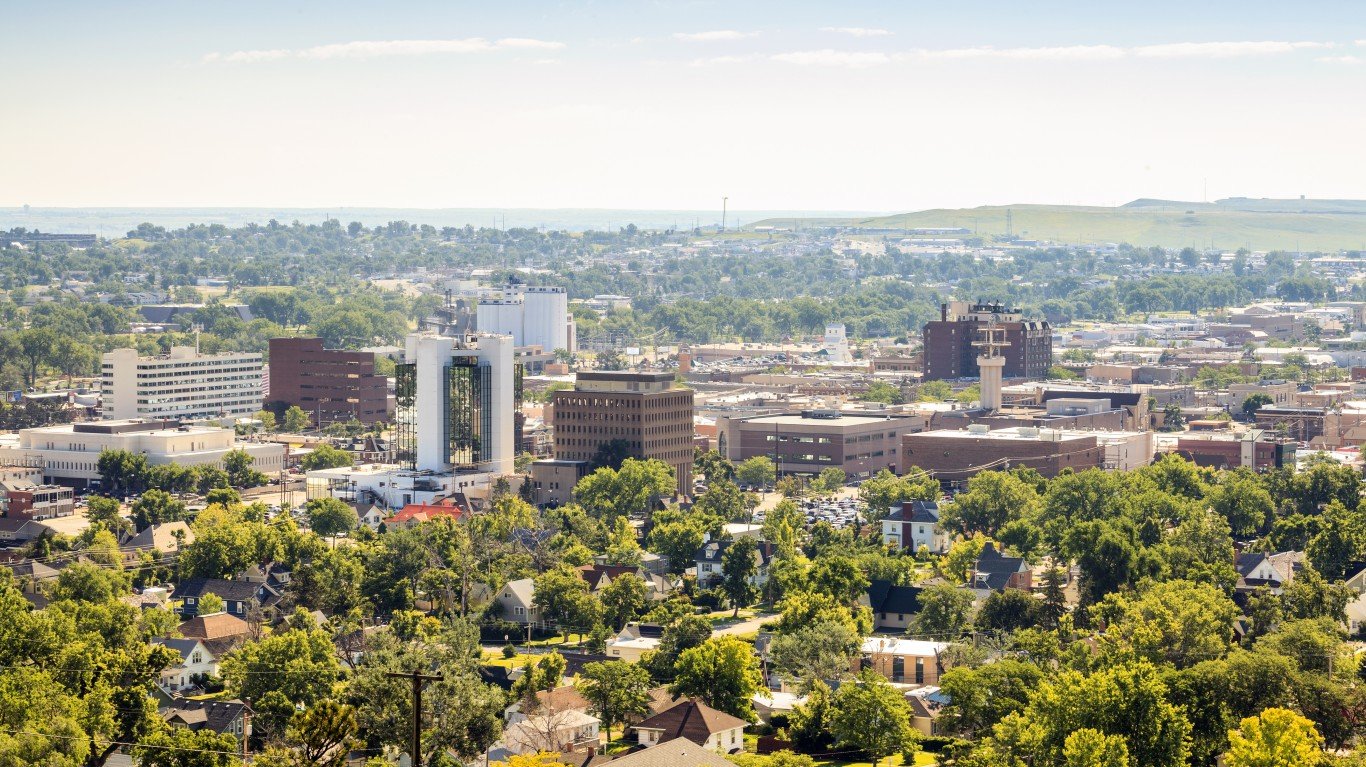
South Dakota: Rapid City
Avg. new daily cases in Rapid City in week ending April 26: 3.4 per 100,000
Avg. new daily cases in Rapid City in week ending April 19: 3.1 per 100,000
COVID-19 cases in Rapid City as of April 26: 39,745 (28,717.1 per 100,000)
Peak pandemic unemployment in Rapid City: 13.8% (April 2020)
Rapid City population: 138,402 (22.2 people per sq. mi.)

Tennessee: Kingsport-Bristol, TN-VA
Avg. new daily cases in Kingsport in week ending April 26: 7.9 per 100,000
Avg. new daily cases in Kingsport in week ending April 19: 4.8 per 100,000
COVID-19 cases in Kingsport as of April 26: 86,530 (28,227.4 per 100,000)
Peak pandemic unemployment in Kingsport: 14.1% (April 2020)
Kingsport population: 306,546 (152.5 people per sq. mi.)
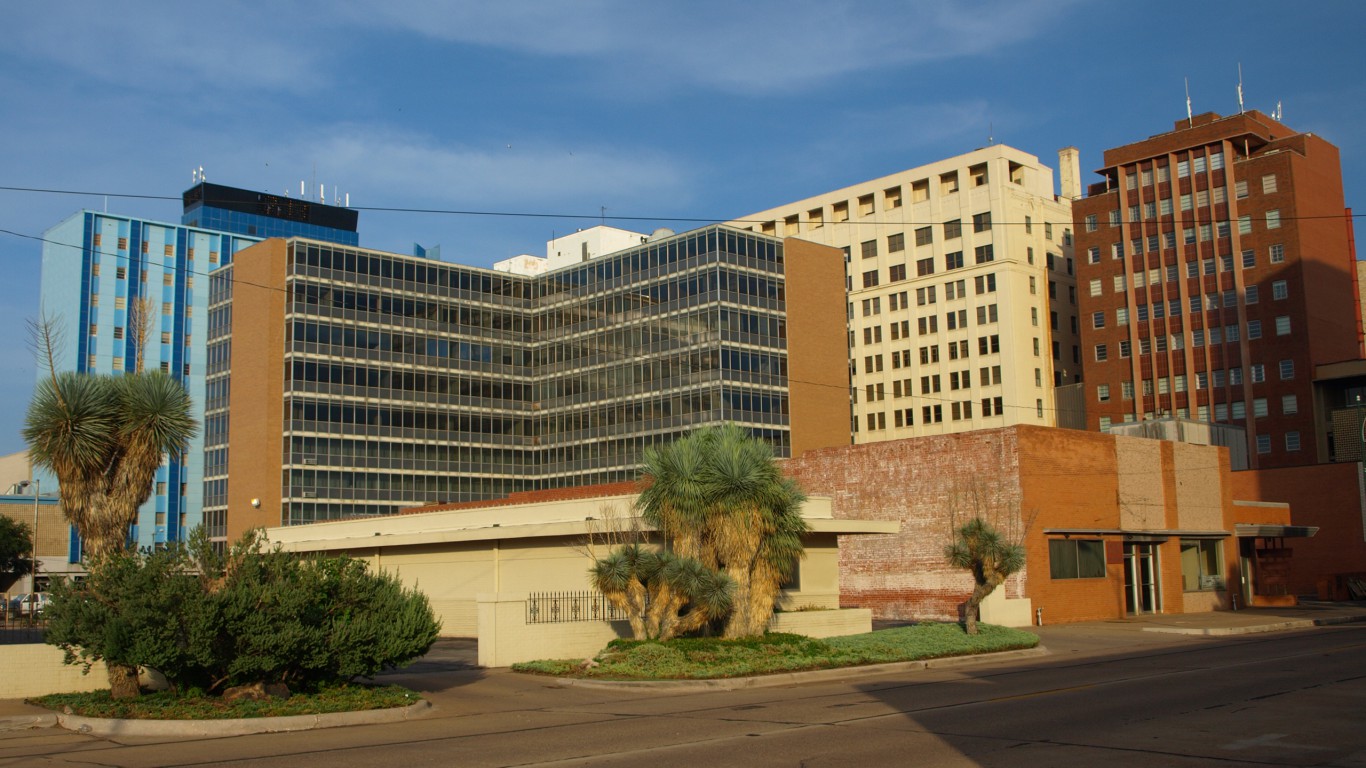
Texas: Wichita Falls
Avg. new daily cases in Wichita Falls in week ending April 26: 65.0 per 100,000
Avg. new daily cases in Wichita Falls in week ending April 19: 40.7 per 100,000
COVID-19 cases in Wichita Falls as of April 26: 33,955 (23,912.1 per 100,000)
Peak pandemic unemployment in Wichita Falls: 11.8% (April 2020)
Wichita Falls population: 141,999 (82.7 people per sq. mi.)
These are all the counties in Texas where COVID-19 is slowing (and where it’s still getting worse).

Utah: Ogden-Clearfield
Avg. new daily cases in Ogden in week ending April 26: 35.6 per 100,000
Avg. new daily cases in Ogden in week ending April 19: 9.6 per 100,000
COVID-19 cases in Ogden as of April 26: 189,593 (28,601.6 per 100,000)
Peak pandemic unemployment in Ogden: 9.8% (April 2020)
Ogden population: 662,875 (91.7 people per sq. mi.)
These are all the counties in Utah where COVID-19 is slowing (and where it’s still getting worse).

Vermont: Burlington-South Burlington
Avg. new daily cases in Burlington in week ending April 26: 57.4 per 100,000
Avg. new daily cases in Burlington in week ending April 19: 48.0 per 100,000
COVID-19 cases in Burlington as of April 26: 43,669 (19,959.9 per 100,000)
Peak pandemic unemployment in Burlington: 14.8% (April 2020)
Burlington population: 218,784 (174.7 people per sq. mi.)

Virginia: Staunton
Avg. new daily cases in Staunton in week ending April 26: 19.8 per 100,000
Avg. new daily cases in Staunton in week ending April 19: 9.5 per 100,000
COVID-19 cases in Staunton as of April 26: 30,106 (24,747.8 per 100,000)
Peak pandemic unemployment in Staunton: 9.9% (April 2020)
Staunton population: 121,651 (121.4 people per sq. mi.)

Washington: Seattle-Tacoma-Bellevue
Avg. new daily cases in Seattle in week ending April 26: 22.6 per 100,000
Avg. new daily cases in Seattle in week ending April 19: 21.9 per 100,000
COVID-19 cases in Seattle as of April 26: 735,317 (18,993.9 per 100,000)
Peak pandemic unemployment in Seattle: 17.3% (April 2020)
Seattle population: 3,871,323 (659.2 people per sq. mi.)

West Virginia: Morgantown
Avg. new daily cases in Morgantown in week ending April 26: 8.4 per 100,000
Avg. new daily cases in Morgantown in week ending April 19: 5.0 per 100,000
COVID-19 cases in Morgantown as of April 26: 34,018 (24,445.8 per 100,000)
Peak pandemic unemployment in Morgantown: 13.3% (April 2020)
Morgantown population: 139,157 (137.9 people per sq. mi.)

Wisconsin: Madison
Avg. new daily cases in Madison in week ending April 26: 28.5 per 100,000
Avg. new daily cases in Madison in week ending April 19: 24.7 per 100,000
COVID-19 cases in Madison as of April 26: 157,600 (24,108.0 per 100,000)
Peak pandemic unemployment in Madison: 11.6% (April 2020)
Madison population: 653,725 (197.5 people per sq. mi.)
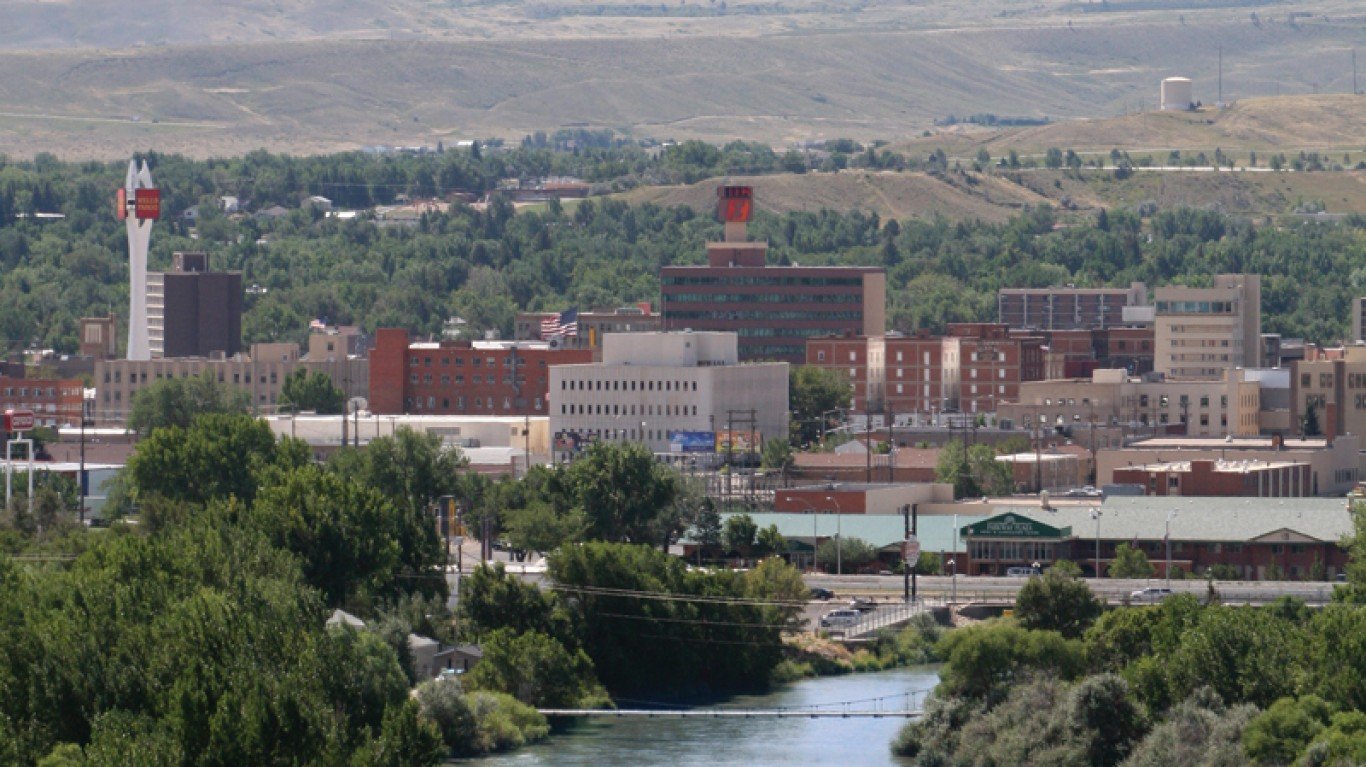
Wyoming: Casper
Avg. new daily cases in Casper in week ending April 26: 2.6 per 100,000
Avg. new daily cases in Casper in week ending April 19: 0.9 per 100,000
COVID-19 cases in Casper as of April 26: 22,288 (27,744.5 per 100,000)
Peak pandemic unemployment in Casper: 12.6% (April 2020)
Casper population: 80,333 (15.0 people per sq. mi.)
Click here to see all coronavirus data for every state.
Take This Retirement Quiz To Get Matched With An Advisor Now (Sponsored)
Are you ready for retirement? Planning for retirement can be overwhelming, that’s why it could be a good idea to speak to a fiduciary financial advisor about your goals today.
Start by taking this retirement quiz right here from SmartAsset that will match you with up to 3 financial advisors that serve your area and beyond in 5 minutes. Smart Asset is now matching over 50,000 people a month.
Click here now to get started.
Thank you for reading! Have some feedback for us?
Contact the 24/7 Wall St. editorial team.




